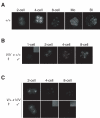Preimplantation expression of the somatic form of Dnmt1 suggests a role in the inheritance of genomic imprints
- PMID: 18221528
- PMCID: PMC2266903
- DOI: 10.1186/1471-213X-8-9
Preimplantation expression of the somatic form of Dnmt1 suggests a role in the inheritance of genomic imprints
Abstract
Background: Identical DNA methylation differences between maternal and paternal alleles in gametes and adults suggest that the inheritance of genomic imprints is strictly due to the embryonic maintenance of DNA methylation. Such maintenance would occur in association with every cycle of DNA replication, including those of preimplantation embryos.
Results: The expression of the somatic form of the Dnmt1 cytosine methyltransferase (Dnmt1s) was examined in cleavage-stage preimplantation mouse embryos. Low concentrations of Dnmt1s are found in 1-, 2-, 4-, and 8-cell embryos, as well as in morulae and blastocysts. Dnmt1s is present in the cytoplasm at all stages, and in the nuclei of all stages except the 1-cell, pronuclear-stage embryo. The related oocyte-derived Dnmt1o protein is also present in nuclei of 8-cell embryos, along with embryo-synthesized Dnmt1s. Dnmt1s protein expressed in 1-cell and 2-cell embryos is derived from the oocyte, whereas the embryo synthesizes its own Dnmt1s from the 2-cell stage onward.
Conclusion: These observations suggest that Dnmt1s provides maintenance methyltransferase activity for the inheritance of methylation imprints in the early mouse embryo. Moreover, the ability of Dnmt1o and Dnmt1s proteins synthesized at the same time to substitute for one another's maintenance function, but the lack of functional interchange between oocyte- and embryo-synthesized Dnmt1 proteins, suggests that the developmental source is the critical determinant of Dnmt1 function during preimplantation development.
Figures






Similar articles
-
Gene expression of Dnmt1 isoforms in porcine oocytes, embryos, and somatic cells.Cell Reprogram. 2013 Aug;15(4):309-21. doi: 10.1089/cell.2012.0088. Epub 2013 Jun 28. Cell Reprogram. 2013. PMID: 23808878 Free PMC article.
-
Stage-by-stage change in DNA methylation status of Dnmt1 locus during mouse early development.J Biol Chem. 2005 Mar 11;280(10):9627-34. doi: 10.1074/jbc.M413822200. Epub 2005 Jan 4. J Biol Chem. 2005. PMID: 15634679
-
Maintenance of genomic methylation patterns during preimplantation development requires the somatic form of DNA methyltransferase 1.Dev Biol. 2008 Jan 1;313(1):335-46. doi: 10.1016/j.ydbio.2007.10.033. Epub 2007 Oct 30. Dev Biol. 2008. PMID: 18048024
-
Conservation of DNA Methylation Programming Between Mouse and Human Gametes and Preimplantation Embryos.Biol Reprod. 2016 Sep;95(3):61. doi: 10.1095/biolreprod.116.140319. Epub 2016 Jul 27. Biol Reprod. 2016. PMID: 27465133 Review.
-
Role of Mammalian DNA Methyltransferases in Development.Annu Rev Biochem. 2020 Jun 20;89:135-158. doi: 10.1146/annurev-biochem-103019-102815. Epub 2019 Dec 9. Annu Rev Biochem. 2020. PMID: 31815535 Review.
Cited by
-
Out of sight, out of mind? Germ cells and the potential impacts of epigenomic drugs.F1000Res. 2018 Dec 21;7:F1000 Faculty Rev-1967. doi: 10.12688/f1000research.15935.1. eCollection 2018. F1000Res. 2018. PMID: 30613387 Free PMC article. Review.
-
Gatekeeper of pluripotency: a common Oct4 transcriptional network operates in mouse eggs and embryonic stem cells.BMC Genomics. 2011 Jul 5;12:1-13. doi: 10.1186/1471-2164-12-345. BMC Genomics. 2011. PMID: 21729306 Free PMC article.
-
Genomic imprinting: recognition and marking of imprinted loci.Curr Opin Genet Dev. 2012 Apr;22(2):72-8. doi: 10.1016/j.gde.2011.12.001. Epub 2011 Dec 21. Curr Opin Genet Dev. 2012. PMID: 22195775 Free PMC article. Review.
-
Epigenetic mechanisms of Strip2 in differentiation of pluripotent stem cells.Cell Death Discov. 2022 Nov 5;8(1):447. doi: 10.1038/s41420-022-01237-5. Cell Death Discov. 2022. PMID: 36335090 Free PMC article.
-
The Vast Complexity of the Epigenetic Landscape during Neurodevelopment: An Open Frame to Understanding Brain Function.Int J Mol Sci. 2018 May 1;19(5):1333. doi: 10.3390/ijms19051333. Int J Mol Sci. 2018. PMID: 29723958 Free PMC article. Review.
References
-
- Mertineit C, Yoder JA, Taketo T, Laird DW, Trasler JM, Bestor TH. Sex-specific exons control DNA methyltransferase in mammalian germ cells. Development. 1998;125:889–897. - PubMed
Publication types
MeSH terms
Substances
LinkOut - more resources
Full Text Sources
Molecular Biology Databases

